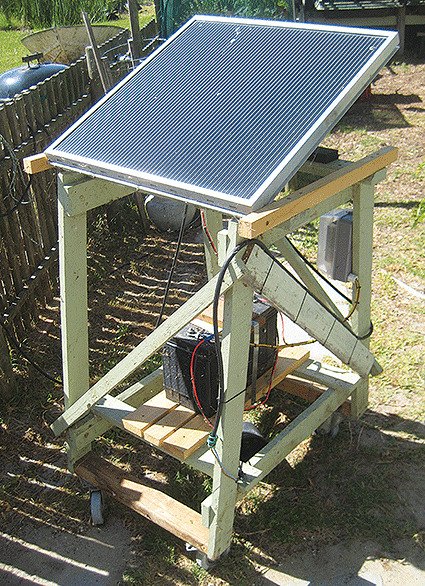
Is it possible for less to be more?
This is a follow-up on the Reduce, Reuse and Recycle article in the February Issue that posed the question: Is such a small amount of power, derived from a 20+ year old PV Panel of any practical use and of positive benefit to as wide range of uses as possible.The objective is to devise a 'means' that would compete with a wind pump, be portable, would capture sufficient energy, store it and then use this to pump water and additionally power a range of 12 V DC devices.
First though, it is necessary to have a mind shift, away from the ubiquitousness (definition: seeming to be everywhere) of a First World setting, to that of a Developing World setting.
The devised 'means' is a self contained, portable, (the old Recycled PV Panel featured in the February Issue is almost the same specification) solar powered water pump unit with added capabilities that would enable rural communities to greatly improve the ability to sustain themselves, have improved health and restore family unity.
Sunlight, although available only during daylight hours, is the preferred choice as a source of renewable energy supply, across large geographic non specific zone areas, for this specific 'means',
The 'means', a PowerBox with a single 40 watt solar panel, charge controller and storage battery to store power for its small 12 V DC pump, will deliver water, drawn from shallow sources of surface water, to drip irrigate small vegetable gardens.
It is portable enough to 'follow' the water supply, much as a rural community might do.
In addition to having a pumping cycle, the Powerbox has sufficient reserve storage to provide lighting, power a small radio or charge a cell phone thus promoting family values by ‘normalising’ the family home.
These features:
• Specific zone requirements.
• Shallow sources of water.
• Portable enough, to 'follow' the water.
• Sufficient reserve storage of renewable energy.
• Power for additional devices.
Mitigate against using wind as an alternative.
Powerbox Specifications:
• Pump: 3.8 litre per minute to a maximum delivery head of 25 metres and self prime head (more with a non-return valve) of 1.5 metres.
• 12 V DC - 2 amperes at normal load increasing to 4 amperes at 25 metres head.
• Able to run dry without damage and handle, via a filter, a wide range of fluids.
• Integral pressure switch to shut pump off at maximum pressure head.
• Battery: 45 ampere/hour capacity, long cycle ‘recreational use’ type.
• Charge controller: 10 amperes to regulate charging levels to the battery.
• Under no load, the panel charges @ 13.5 V DC to 13.75 V DC.
• Under load, the panel maintains 13 V DC.
• Cycle: 2 hours pumping with 6 to 8 hours charging yields +/- 450 litres of water daily.
Irrigation potential:
Based on actual water usage, conducted over a number of years in my experimental garden, 2 litres per m2 is sufficient to irrigate vegetables when water is delivered below surface directly to the plant root zones as this considerably reduces evaporation loss.
The need to optimise water usage as much as possible is critical to meet the needs of a growing World population - 6.44 billion in 2004 - 7.7 billion as of 2019 = an increase of 1.26 billion in just 15 years - that faces reduced water availability brought about by weather changes.
The Powerbox, delivering 450 litres daily output will irrigate 225 m2 of vegetable garden, thus has the potential to 'feed' 22 x 5 member families (planted area 10m2 each family) or some 110 people.
Additional:
After the daily irrigation demand, the Powerbox would be moved into the user's home and placed on a stand. A table top of suitable size placed on top of the Powerbox, as per the example below, will then convert it into a dining/working area for the whole family.
A 12 V DC Light Emitting Diode (LED) lamp placed to illuminate its surface will provide the family with a safely illuminated working surface for eating, study or family gathering.
As there is sufficient reserve power stored for approximately 4 hours nightly use, additional (6 to 10) LED units could be installed in the home to provide illumination that is vastly safer for the family than candles or paraffin.
Additional uses for the Powerbox would be to provide instant, fuel-less, safe voltage, portable power for radio, cell phone, computer etc.
Subsequently:
Since 2004 the Powerbox has been seen and presentations done to numerous interested groups.
Its concept was not easily grasped then as there was little, environmentally, about being prepared for the effect that climate changes/population increases would have on global water supply demands.
Increasing awareness, that we need to harness environmentally sustainable energy sources, has seen a massive increase worldwide in the use of PV panels (as well as wind) to feed power to grids and individual users.
The original PV panel, charge controller and larger deep cycle battery have been mounted, as per the following picture, on a stand with castors that allow the whole to be manually rotated or relocated to an optimum sun position.
It now pumps a daily amount of water from a shallow 3.5 metre deep well, using a newer version of the original 12 V DC pump, as per the photograph below, to an elevated tank that feeds the water to our 2 toilets and so puts us 'off the grid' - power and water - completely.

